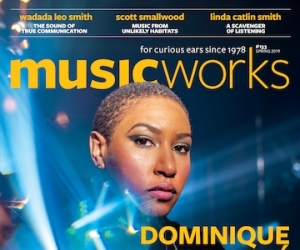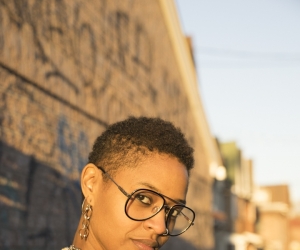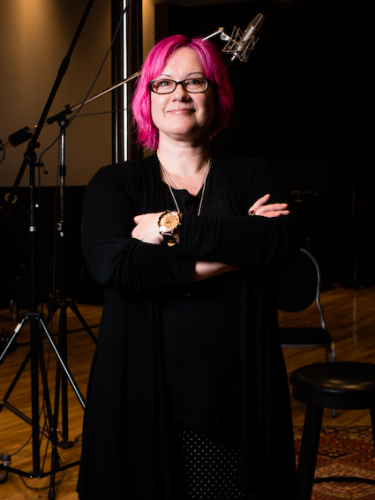
IT ALL CAME BACK SO FAST: the Whip, the Punch, the Elements. All those gestures unlocked my voice and made it respond exactly as it was supposed to—even after a five-year absence.
Late last year, I embedded myself with the Element Choir, the world’s leading structured-improvisation choral group, as it prepared for one of its largest gigs to date—backing up acclaimed Inuit throat singer Tanya Tagaq at Toronto’s Massey Hall, part of a double-bill concert with indie chamber composer Owen Pallett. This was not my first experience of being in the Choir. I was a regular member from 2008 to 2010. At rehearsal, I received some good-natured and well-deserved ribbing for rejoining the ranks after an extended hiatus so I could perform at this prestigious concert presented at one of Canada’s most storied live-music venues.
Led by inimitable vocalist, teacher, conductor, and organizer Christine Duncan, the Element Choir has become a musical community unto itself in Toronto over its near-decade-long history. Freely improvised, but conducted by Duncan using her own unique vocabulary of hand signals, the Choir creates vocal soundscapes that range in dynamic from ethereal whispers to guttural screams. The Choir’s personnel is equally diverse, with membership covering a range of ages, backgrounds, and musical skill levels. Membership is open to anyone interested in participating. It even took in a scruffy punk rocker turned new-music presenter, such as yours truly.
What I love about singing with the Element Choir is the feeling of mixing total abandon with total discipline. There is the sense that things could go off the rails at any moment and, as with all improvised music, there are no wrong notes or moves. At the same time, it is also crucial to keep your eyes on Duncan, so as not to miss cues and therefore stick out like a sore thumb. Listening is just as crucial as looking: you have to pay attention to what the fifty-nine other people around you are doing and not lose yourself in unfettered self-expression. But within those strict limitations set by Duncan the conductor, everything is permitted: squelches, squeaks, shrieks, clucks, quacks, clicks, pops, “record” scratches, teeth-sucking, free-form whistling, and extemporaneous, stream-of-consciousness talking (an Element Choir cornerstone that is to me, strangely, the most stressful exercise). Most joyful of all is the creation of massive group drones, bending up or down in pitch with a twist of a thumb from a mischievously grinning Duncan.
In a way, the Element Choir is a microcosm of society, or possibly a utopian version thereof: individual freedom of self-expression, bound by rules that prevent the individuals from harming the larger group, and governed by a benevolent leader. Christine Duncan—the shining star at the centre of the Choir’s solar system, and around which we erratic vocal planetoids orbit.
Duncan uses a group email list to keep in touch with and organize the Choir. There are around 200 names on the list, with many original members among them. “I think,” she mulls, when asked what she figures has kept so many people so committed for so long, “that’s pretty complex. First of all, there’s nothing else quite like making sound as a group of voices together. It’s transformative. And that’s been around since the beginning of the species. And that’s a big part of it: the fact that there’s a shared experience, which can feel very precious. Community develops out of it; people meet each other in this environment and you hear about spinoff projects all the time—Element Choir people getting to know each other, collaborating and creating bonds and friendships with each other, from within the group.”
Duncan pauses.
“But also … people just really like me!”
Christine Duncan is not lacking in confidence.
“That sounds bizarre for me to say,” she continues, “but I’m saying that in a way that’s really objective. I work really hard to be magnetic and likable and inspirational. It’s very important to me as a spiritual path.”
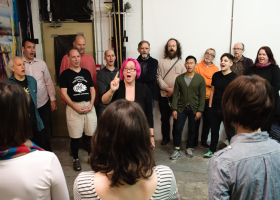
DUNCAN'S LIFE STORY HAS TAKEN HER A LONG WAY from her roots in British Columbia to her current life in Toronto, and her career as both a vocal teacher and an improvising voice artist.
“I’ve had a very, very interesting life,” she begins. “I was raised in a fundamentalist, born-again, Pentecostal family. My father is a minister, a preacher. My family was a travelling performing musical family, The Duncans. And we travelled all over the place; he preached, we sang. I started writing songs when I was twelve—Christian folk-pop, evangelical stuff. When I was fifteen, we went to Nashville, which was kind of unheard of in those days, and recorded two records, one of which was all songs that I wrote. So that was really where it all came from, for me.”
In her late teens, Duncan was turned onto R&B, blues, and jazz, through friends. Her life as a jazz vocalist began when two friends who were getting married asked her to sing a couple of standards at their wedding. Her own wedding, as it turns out, sparked the end of her life in the church.
“I got married when I was really young to a guy who was a minister’s son, and since I was a minister’s daughter, we had a sort of royal wedding—about 450 people came out. The marriage went south very quickly. I had to leave; I had to get out of the situation. But that did not go over well in the church, because they do not believe in divorce or separation. So I, in effect, got kicked out of my church. But it was also the bow-and-arrow effect: Boom! I’m out. [She slaps her hands for effect.] And that was it, and I never looked back.”
After that, Duncan won a scholarship to a school of the arts in Vancouver, where she befriended piano player Miles Black. He introduced her to the city’s jazz scene and, in turn, one of her first real mentors, pianist Bob Murphy (who sadly passed away the day of the interview for this article). A few years down the road, Duncan auditioned for a part in a new-music opera by Peter Hannan. “That spurred my shift and interest into more new music—new composed, experimental kinds of stuff,” she recalls. Her budding interest in improvisation was also stirred by another mentor, trombonist and pianist Hugh Fraser, who founded the Vancouver Ensemble of Jazz Improvisation (VEJI). Fraser also organized the jazz orchestra workshops in Banff that gave Duncan the opportunity to connect with artists from Europe, where, she says, “it’s all kind of mixed up and people do nonidiomatic improvisation and new-music composition and jazz.”
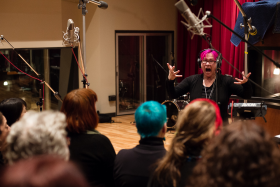
DUNCAN MOVED FROM VANCOUVER TO TORONTO in 2000, and quickly immersed herself in the city’s new-music and improvised scene. Jazz presenter Ron Gaskin was an early champion of Duncan’s work, so impressed with her outgoing persona that he invited her to cohost the Music Gallery’s weekly radio show, Radio Music Gallery, on University of Toronto campus station CIUT 89.5 FM (a show yours truly ended up hosting a couple of years later).
“I got a bunch of free concert passes through the radio show, and I started going out like crazy, checking out music all over the
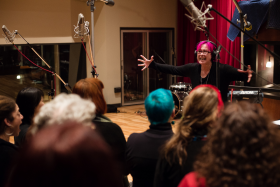

city almost every night to see what scene I connected with,” recalls Duncan of those heady days. “The improvising scene is the one I really feel like I landed in the best. And I just started playing with people. If you show up, things happen.”
At the end of 2000, Duncan was in Vancouver to do a show and spend the holidays with her family. At a gig by folk duo Zubot and Dawson, the violinist Jesse Zubot introduced her to the band’s drummer, Jean Martin. “I recall being right at the back of the room, around the corner from where they were playing, and as soon as I heard the drummer, I said to my friends ‘Hang on, I gotta go check out this drummer.’ It was something about the feel and the groove that pulled me over from the other end of the bar.”
Duncan and Martin were life partners before they started playing music together. For a short time, they lived in an old farmhouse between the Ontario cities of Oakville and Burlington. “We made farm and barnyard jokes regularly,” she recalls. “While we were living there, the [Distillery Music Festival] started in Toronto. Jean saw that [it was] taking applications for performers and applied for the two of us to play as a duo and called it Barnyard Drama, based on one of our ongoing jokes about our living arrangement. We got accepted to play the festival. Then we had to figure out what we were going to do and our band Barnyard Drama was formed.”
Barnyard Drama’s debut album, Memories and a List of Things to Do, was released on Martin’s own label, Barnyard Records, in 2003. The duo was soon turning heads in the Canadian improvising community with its blend of Duncan’s fiery soundsinging and Martin’s propulsive drumming and disorienting turntable work, their live shows driven with rock-band intensity. I’m a Navvy, the duo’s sophomore disc, upped the avant-rock factor even further with the addition of guitarists Bernard Falaise and Justin Haynes. Barnyard Records continued as a going concern, with Martin releasing discs by all affiliated projects, as well as countless improvising artists from Toronto and beyond, including Kyle Brenders, Anthony Braxton, Nic Caloia, the band Drumheller, Colin Fisher, Nick Fraser, Lori Freedman, the Not the Wind, Not the Flag duo, Evan Parker, William Parker, The Reveries, John Southworth, and Rainer Wiens. And the Element Choir, of course.
In 2006, the duo and their Vancouver friend DB Boyko released an album called Idiollala on the Montreal label Ambiances Magnétiques. “We were doing CD-release concerts in Toronto and Montreal that November and were talking about how stark it felt to have a whole concert of just two voices and drums improvising,” Duncan recalls. “Jean suggested that we put together groups of singers that DB and I could conduct during the shows. We were able to do that in each city, and it turned out so well that Jean and I decided to apply for a grant for me to develop a vocabulary for improvising choir and to put a group together on a more permanent basis. We were successful with the grant and over a nine-month period in 2007 we built the Element Choir and concept.”
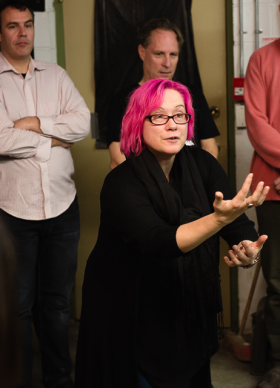
THE VOCABULARY OF HAND SIGNALS that Duncan uses to conduct the Choir has become central to its method and aesthetic, and this gestural language has evolved slowly and gradually over the years. “The whole process has been pretty organic,” remarks Duncan. “A lot of what I did at first was to research existing systems of conduction that I was aware of: Butch Morris, the London Improvisers Orchestra, Anthony Braxton, who uses some hand cues in his large ensemble work, Cobra by John Zorn—a game piece really, but some secondary hand-cue stuff—and Soundpainting by Walter Thompson. During that time, I also hosted a Feral Choir workshop for Phil Minton to see how that functions. Between all of these things, and sessions with some advisors (Juliet Palmer, Peter Hannan, and Jean Derome), as well as constant discourse with Jean [Martin], we have developed a vocabulary, which is part appropriated and part invented. I do keep tweaking things, adding specificity and even new cues, where there seems to be the need—and often choir members are involved in this discussion, as well.”
For Duncan, finding her voice in improvised music was in some ways an unexpected return to her roots in the Pentecostal church. “I was raised in a communal environment where people improvised all the time. We have what are called praise-and-worship services, where people are speaking in tongues: glossolalia. And I had been doing that since I was a little kid, and improvising freely in a group. When these things really get rocking, people are just doing what they want, all together at the same time. It’s glorious, that sound. And I’ve found that sometimes in the Element Choir, it’s like, ‘Yeah!’ I get a hit of that same kind of thing. It’s a beautiful, beautiful feeling.”
In the early days, the Choir’s gigs were mostly small, community-based affairs. I have fond memories of participating in a ten-person version in a tiny, now-shuttered café on Queen Street West, and another with a slightly larger number of voices at a covert ravine party held under a train bridge next to the Don River, as part of the now-defunct Extermination Music Night series. Although the Choir frequently and comfortably occupied atypical performance spaces, it was most in its element (so to speak) in the pristine acoustic environment of churches: the Music Gallery’s home at St. George the Martyr Church, or larger sanctuaries such as Rosedale United, where the Element Choir’s first CD was recorded. The largest Choir event I performed in was part of something called The Sonic Fun House, at Scotiabank Nuit Blanche 2009. We set up shop at the Church of Consumption—also known as the mall—for an insane twelve-hour overnighter during which multiple versions of the Choir were augmented by an improvising instrumental ensemble—an event that I also curated, as artistic director of the Music Gallery at the time. But the most memorable occasion was the launch of the Choir’s first CD: a concert featuring a 100-person choir and a host of instrumental accompanists, including U.S. improvising bassist William Parker, which was held in front of an audience of more than 500 people at Christ Church Deer Park in 2010. If foggy memory serves, this was also my last Element Choir show before life and its attendant distractions took me over.
The Choir fell off my radar for a while. Then, in September 2014, I noticed a few old Element Choir friends’ excited and nervous Facebook posts about a gig at the Carlu. The story was that the Element Choir had been invited to back up Tanya Tagaq for a nine-minute performance at the gala for Polaris Music Prize (the Canadian equivalent to Britain’s Mercury Prize). The iconoclastic Inuit artist had been nominated for the music critics’ award for her album Animism—which ended up winning. As far as collaborations go, this match-up was not a huge surprise. Martin, Duncan’s partner, is the drummer in Tagaq’s band, which also includes fellow free-improvising superstars Jesse Zubot on violin and Bernard Falaise on guitar. Duncan had also joined the group, for what she calls “the most fucked-up back-up singing gig in the world!” The Element Choir proved the perfect sonic backdrop for Tagaq’s guttural growls, not to mention her fully improvised performances. “When the Polaris awards came up, Tanya wanted to do something really big and fun and kind of crazy, so Jean [Martin] suggested the Element Choir to back them up and she said, ‘Yup. Exactly.’ We were asked to do it a week before the show. There was about forty-five of us at it and it was insane, and it just stuck as something where the chemistry is so great.”
The Polaris engagement led to more and larger opportunities for the Choir: a concert at Toronto’s Great Hall in November 2014, an invitation to participate in the massive R. Murray Schafer piece Apocalypsis at Toronto’s LuminaTO Festival in June 2015 (in which Tanya was also, coincidentally, a featured performer), and, two months later, a performance backing up Tagaq at a free show for thousands outside Toronto’s City Hall as part of the Pan Am Games’ cultural festival, Panamania.
“For my entire life, it’s all been about relationships: creating and maintaining them and keeping them strong, being honourable in them. And they just keep giving,” says Duncan, who’s not at all concerned about losing the intimate, community groove as the Element Choir moves from cafés and ravine parties and allnighters in the mall to grander locales.
“It’s exactly the same group,” she avers. “I’ve been on stage my entire life, so I don’t get starstruck and I don’t get freaked out. The way that I run the group, it’s the same relationship, it’s the same intimacy. I’ll say to people, ‘Okay, it’s going to be loud, there’s going to be bright lights, but make sure you keep your eyes on me, otherwise you’ll miss the cues.’ If the whole feeling or tenor ramps up for the event, then I ramp up my energy to match it, to keep the connection stable—because it’s got to be stable.”
Bringing a sixty-member choir to a professional concert stage is a huge responsibility, especially when many of its members are amateur or untrained musicians, and especially when the material is improvised; it’s a situation that could potentially lead members to feel emotionally naked or vulnerable in public. Duncan is, thankfully, unafraid to assume responsible for their safety as choir leader.
“What comes back to me is that they feel very secure because I’m taking responsibility for their security,” she says. “I’m going to make sure that they don’t fall on their asses. It’s also a strength-in-numbers thing. They’re not being hung out there on their own to bear the weight of their performance. For these gigs with Tanya, we’re there to support what’s going on.” [In rehearsal, Duncan calls it a wall of sound.] “But we do a lot of shows that are bigger—even just with the choir. But I only ask people to do things that I know they’re ready to do, first of all. And secondly, I’m very clear with people that if they don’t want to do it, they can say no. And again there’s no risk in that—though it’s risky; the whole thing’s risky. But in terms of feeling like you’re unsupported or unsafe, I’ve taken care of that, so if people do make those choices, they’re making it because they actually want to do that instead of feeling obligated or pushed.”
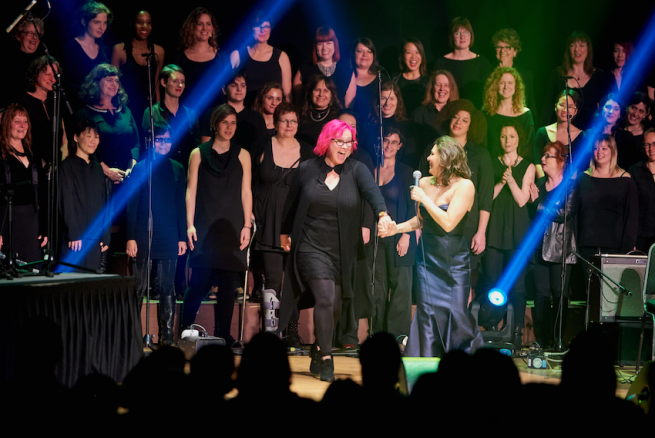
MY OWN RETURN TO THE ELEMENT CHOIR WAS BEAUTIFUL, a return to a mode of self-expression that I had drifted away from, but which, I discovered, had not faded within me. It was very, very easy to reconnect with that voice, and the language of hand cues came back to me very, very quickly: a testament to the brilliantly intuitive system that Duncan has devised. Stepping onto the stage in front of over 2,000 people at Massey Hall was overwhelming, but in the best possible way: I was bowled over by the depth of the sound and the curiosity of the crowd, yet in the hands of our Choir leader, I indeed felt completely safe and at home. All eyes in the audience were on Tanya Tagaq, but all our eyes were on Christine Duncan. I was so swept up in the moment, that the entire eighty-minute performance—one long, uninterrupted improvisation—felt like it went by in about five minutes.
If I may say so, we killed it.
It’s sadly ironic that 2,000 people came out to see a concert of improvised music in a town in which a fifty-person venue for improvised music could not keep its doors open. At least Tanya Tagaq, a regular visitor to Toronto, has been able to bring this unique, distinct musical culture to a wider audience. Christine Duncan and the Element Choir are national treasures and deserve to be recognized as such. Let’s all do our part to ensure creative communities like this have the chance to thrive in spaces small and large.
FYI: In May 2016, Christine Duncan and Element Choir will perform at Festival International de Musique Actuelle de Victoriaville (FIMAV) and at The Royal Conservatory of Music’s 21C Festival.
Bottom photo: Courtesy of Live at Massey Hall / Malcolm Cook. All other photos by: Kevin Jones.
